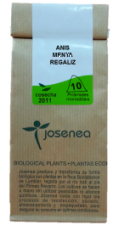- Description
- Features
- Ingredients
- Brand
Features:
There is a wide variety of mint species. Until the 17th century, all of them (Mint, Pennyroyal, Peppermint, etc) were used in the same way, and no real attempt was made to differentiate their varieties.
Today, in the West, Peppermint is the most widely used. The leaves and flowering tops are used.
How to use: Infusions
Presentation: Pyramid
Quantity: 10 Bags
Composition: Anise, Chamomile and Licorice.
- Reference8436535154949
-
Brand
Josenea
Constituents: The leaves contain minerals, flavonoids (derivatives of apigenol and luteolol, menthol), a bitter principle, tannin, triterpenes (ursolic and oleanolic acid), phenolic acids (coffee, chlorogenic, rosmarinic, etc), but their principle The main active ingredient is the essential oil rich in free and esterified menthol (saturated monocyclic terpene secondary alcohol), terpene carbides (pinene, limonene, phellandrene), menthone (ketone corresponding to menthol) and menthofuran. Its content in flavonoids, bitter principle and essential oil give it stomachic properties (stimulates the secretion of gastric juices), carminative, antispasmodic, choleretic and cholagogue. Characteristics: Plant used for more than 3,000 years. Root and rhizome are used. Constituents: Contains a triterpene: glycyrrhizin, which is transformed into glycyrrhetic acid, increasing the secretion of gastric mucus and decreasing the secretion of pepsinogens. Glycyrrhizin, in addition to its anti-ulcer action, has sweetening, expectorant, antitussive and healing power. Contains liquiritosido and isoliquiritosido (flavonoids) with antispasmodic action. Another flavonone has recently been found with anti-ulcer activity, superior to glycyrrhizin. It is 3-di-(methyl-hexunorate)-4, 7-dihydroxyflavonol. It also contains: sucrose, dextrose (5-10%), starch (30%), protein, fat, essential oil, resins, asparagine.


